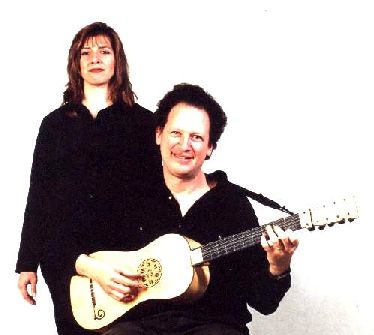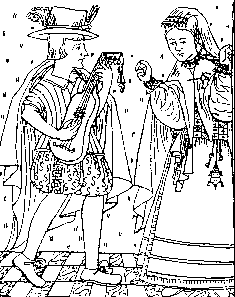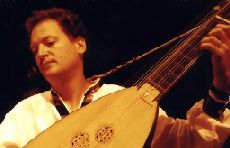
photo by Martin Babino

photo
by Martin
Babino
Music and Poetry in Baroque Peru and Mexico The Codex Zuola (Peru) The "Códice Fray Gregorio de Zuola", which came from Cuzco (Peru), was one of the first documents about ancient Latin American music that musicologists became aware of. It was given to Ricardo Rojas, the Argentinian pioneer of research concerning literature, and arts in general, in the Americas of the seventeenth and eighteeenth centuries. Even though it was "discovered" as long ago as the 1930s, this manuscript remains enigmatic in a number of respects and this has deterred many musicians. Despite the difficulties in understanding it, the songs in this codex are illuminating, and not just because of their undoubted artistic value. They also cast light on an area of musical performance that is poorly documented. The Zuola codex is also of great interest in itself because it can be seen as an intermediary between the Hispanic tradition of tonos humanos and the traditional monody of the southern Andes area of Peru. One was transmitted in writing, the other orally. The manuscript contains 18 songs that appear to be from the same source. Taking as their starting point the vocal parts of Spanish polyphonic songs, they went into circulation across the Iberian peninsula and the American colonies, changing according to the taste of the various social groups that adopted them. It was after this stage of oral transmission that they then again appeared on paper - at the hand of Zuola. Even this would not have arrested the process of change: it may well have continued independently of the written text. But this does not prevent us from considering the songs to be part of a defined tradition, that of the tonos humanos, or secular polyphonic songs of the baroque period. This tradition spread across the whole Spanish empire. (Dime Pedro) Of the 16 secular songs in the manuscript, one presented in two versions that correspond, both as to text and music. Nine other songs correspond with works elsewhere (four with respect to their texts, and five with respect to text and music). These correspondences demonstrate clearly the peculiar dynamic of the tonos humanos which circulated in different guises and in different musical contexts - as secular songs, theatre music for comedies and dramas, religious villancicos, dances and diferencias (variations) for harp or guitar. The tonos were generally written as choral songs for three or four voices and, later in history, as solos or duets with basso continuo. In contradistinction to this practice, the notation of most of the melodies in the Zuola codex is monodic, with out a bass part, in the manner of popular song. We have sought to reconstruct the pieces presented here in the way in which they might have been heard and interpreted in their own epoch. The pieces are set to music in a simple, subtle and delightful manner that shines through the mysteries that we may find in them, limited as we may be in the way we look at things and because of our own tendency to rely on a written tradition. The texts of Lope de Vega , Calderón de la Barca and their contemporaries, filled with beauty and refinement, take on a radiant and living form through an eye that attempts to integrate a "wise" ancient music with the folk music of an oral tradition. Guitar music in baroque America In addition to the pieces drawn from the Zuola codex, we have chosen some works for baroque guitar taken from various manuscripts discovered in Mexico. These manuscripts demonstrate a fertile and lively field of musical and instrumental development, completely apart from the great works of religious music belonging to the colonial past. When we examine the records of secular life in Latin America before the independence movement began right at the start of the nineteenth century, we find numerous references to the presence of guitars, treble guitars and vihuelas. The guitar appears in the context of dance, poetry and popular song and the night-time activities of creole, half-caste and black people. Occasionally it appears in the context of opera productions. The various types of plucked-string instruments "imported" by the conquistadors took on new characteristics with the passage of time. These can be traced to their use in folk music, in which the rich tradition of eighteenth-century Spanish music blended with the contributions of native people and black people. This fusion gave birth to instruments like the charango, the cuatro, and the bandola llanera of Venezuela, and the jarana of Mexico. Codice Saldívar 4 This was found by chance in a second-hand book shop by the musicologist Gabriel Saldívar in the early1940s. This carefully prepared manuscript is attributed to the Spanish guitarist, Santiago de Murcia (1685-1732) who spent his last years in Mexico. It gives us a rich portrait of characteristic guitar pieces belonging to the Spanish context (Marizápalos, Jácaras, Canarios, Marionas, Minuetes and others) written with great refinement and a clear knowledge of the instrument. It combines the "rasgueado"(1) style, characteristic of the five-course guitar, with the plucked style. We have taken the following works from the manuscript: Las penas, a piece that is full of lyricism and wistfulness; Canarios, and a very popular dance that is full of joy; Las sombras, particularly chosen because of its similarity to a piece in the Zuola Codex (that is, No sé a qué sombras funestas) and with an air from the opera La púrpura de la rosa by Tomás de Torrejón y Velazco, first performed in Lima, Peru, in 1701.Two other pieces from this manuscript are presented here: El amor, a work that recalls an air from the opera La púrpura de la rosa, and Marionas, a dance that is very popular in style and resembles an Italian chaconne. El amor is preceded by a short prelude ( from Resumen de acompañar la parte con la guitarra, Madrid, 1714) by the same composer and widely known in Mexico. In Marionas we have added a second part written for a guitar tuned in A to the original text. 'Manuscrito 1560' (Biblioteca Nacional de México) This was probably written by a pupil of Murcia or by an unknown Mexican guitarist. It contains a large number of light pieces and dance pieces as well as minuets and transcriptions of Corelli’s violin sonatas. It is rather uneven in musical quality and generally does not bear comparison with the Codice Saldívar or the Resumen de acompañar la parte. However, there are some exceptions, in the case of some pieces that display a similarity to pieces in those two documents and some other pieces selected for this recording. We have selected Minuetes -two minuets, followed by a third minuet from the Resumen de acompañar la parte, practically identical to one in the Manuscrito 1560. Then there is the delightful Guastala, and finally an untitled piece that we have provisionally called Rondó, but could later discover -thanks to Isidoro Roitman-, that this piece is concordant with "La nueba Forlana" of the "Resumen para acompañar la parte". The last two works are presented first in their original form for solo guitar, then in a version for two equal guitars (that is, guitars in E with five courses). The part for the second guitar was specially written for this recording. Notes on the reconstruction The works from the Zuola codex, apart from Dime Pedro and Porqu’ tan firme os adoro have been reconstructed in a number of areas. First, the rhythmic values had to be adjusted because they did not correspond to the accents in the text, and this was most complex in the case of Que importa yo lo calle. Then there was the restoration of the regular rhythmic structures that had been obscured by the notation used in the original text. Finally, we had to work out an instrumental accompaniment ina manner appropriate to the character of each piece. This was because, except in the case of the polyphonic pieces, the melodies are without any bass part or any guide as to an accompaniment. In creating these accompaniments, we took as our starting point the style that was predominant in the hispano-creole context in the large American cities of the seventeenth century, as expressed in the tonos humanos and the tonadas of the Spanish operas of this period (2) and in the romances of the Spanish vihuelists of the sixteenth century (notably Alonso Mudarra and Luys Milán). It was on this basis that we managed to work out the accompaniments for five-course guitar (3) and vihuela. These take the form of a basso continuo in certain cases. In other cases these take the form of an "alphabet for guitar" (a seventeenth-century system that can be compared to the accompaniment, in popular and folk music of Latin America, by chords or by American numbering) as well as the form of tablature for vihuela in a style approaching that of the Spanish renaissance tradition.
(1) Rasgueado is a manner of playing in which the strings are strummed rhythmically with the nails of the right hand, while the left hand is used to play chords on the neck of the guitar.
(2) For example, La púrpura de la rosa by Tomás de Torrejón y Velazco, based on a libretto by Calderón de la Barca, first performed in Lima, Peru, in 1701, and El robo de Proserpina y la sentencia de Júpiter by Filippo Coppola, based on a libretto by Manuel García Bustamante, first performed in Naples in 1678. In both these cases it is worth noting the abundance of narrative airs based on the repetition of the same musical pattern against which the texts change as in a recitative. In fact, in the EL robo de Proserpina some of these airs contain up to nine couplets. The hypnotic effect of the constant repetition of the musical pattern actually facilitates the listener’s concentration on the meaning of the text. All the pieces from the Zuola codex employ the same form, in this way allowing us to appreciate the poetic richness of the texts.
(3) This was the instrument of choice for accompaniment in seventeenth century Spain and in the secular context during the colonial period. Moreover, in the Zuola codex there is a page with an engraving of this "alphabet for guitar". This encourages us to think that the use of the "alphabet" in the reconstruction of the pieces is fully justified.

Bárbara Kusa was born in San
Luis (Argentina). She began her study of music there, but moved to Buenos Aires
to pursue her studies in the Facultad de Artes y Ciencias Musicales in the
Catholic University of Argentina. She was awarded a degree in choral direction
and is now continuing her studies in singing with Professor Mónica Capra. Her
teachers have included Néstor Andrenacci, Josep Prats, Werner Pfaff, Monique
Zanetti and Renata Parroussel.
She has made several concert tours in Argentina, Brazil, Bolivia, Spain, Canada, Belgium, Germany, France, Italy and Switzerland with several ensembles, including the Coro Polifónico de San Luis, Pigmalión, the Compañía Los Festinantes, Cantica Nova, Proyecto Croma, Ensemble Elyma and the Ensemble Louis Berger. As a soloist she includes in her repertoire works by Schubert, Brahms, Mozart, Monteverdi and Vivaldi as well as works by the Jesuit missions of Chiquitos (Bolivia, 18th century). She has often sung under the direction of Néstor Andrenacci, Javier Zentner, Claudio Morla, Ricardo Massun and Gabriel Garrido.
She featured soloist roles in the following operas: Monteverdi's"L'Orfeo" (Teatro Colón de Buenos Aires, 2001), Rameau's"Castor et Pollux" (2001-2002), Filippo Coppola's (1678)"El robo de Proserpina" (Teatro Avenida, Buenos Aires, 2001), Rameau's "Les indes galantes" (Teatro Colón, 2002), and Lully's"Armide" (Festivales Musicales, 2003).
She took part in the experimental theater group "Periférico de objetos" performance "Monteverdi Método Bélico" as a member of "Ensemble Elyma" (Gabriel Garrido). This play toured France, Belgium and Germany in 2000, and finished in Buenos Aires, acclaimed as the theater event of the year.
She has made several recordings as a soloist and as a member of the various ensembles to which she belongs. Among the discs made for Argentine and French labels are "Música en las Reducciones de Chiquitos" and "Convidando está la noche"(Grupo de Canto Coral - Néstor Andrenacci), "Veneno de los sentidos" and "Cortesanos del Tajo" spanish baroque (La compañía del Tempranillo -Miguel de Olaso) "Vêpres solennelles de Saint Jean Baptiste"(Ensamble Elyma-Gabriel Garrido), "Missa de Lima - Venid Deidades" (Ensamble Louis Berger-Ricardo Massun).
With "La rosa púrpura del Plata", Bárbara Kusa recorded for Voice of Lyrics (France): El Amor, las penas y las sombras (VOL BL 701), including Peruvian and Mexican secular music, which has been awarded by the "2002 CAMU-TRIMARG-UNESCO" (member of Conseil International de la Musique-UNESCO) .
Gabriel Schebor
Gabriel Schebor pursued his
musical studies in his native city of Buenos Aires (Argentina) at the Juan José
Castro Regional Conservatorium of Music, where he was awarded a diploma in
advanced guitar teaching. His teachers were Graciela Pomponio, Dolores Costoyas
and Víctor Villadangos. He also attended advanced courses taken by Jorge Martínez
Zárate, Eduardo Isaac, Roberto Aussel, Eduardo Egüez, Carlos Ravina, Hopkinson
Smith and Gabriel Garrido.
He has given numerous concerts in Argentina, Uruguay, Brazil, Bolivia, Germany, Switzerland, Italy and France. He has also been a guest artist at several festivals, and in particular the Festival International de Sarrebourg (France), Festival de Chiquitos (Bolivia) and the Primavera barroca de Rio de Janeiro (Brazil). Gabriel Schebor has played basso continuo on many an occasion for the Ensemble Louis Berger (under the direction of Ricardo Massun) and the ensemble Elyma (under the direction of Gabriel Garrido). With the same artists he took part of the first south-american audition of Monteverdi's"L'Orfeo", Rameau's "Les indes galantes" in Teatro Colón de Buenos Aires , and Filippo Coppola's "El robo de Proserpina", and de'Cavalieri's "Rappresentazione di Anima et di Corpo" in other argentinians theater's.
His solo repertoire includes 17th and 18th century French and Italian music for lute and theorbo, as well as Mexican and Spanish works from the same period for baroque guitar. She took part in the experimental theater group "Periférico
He took part of the experimental theater group "Periférico de objetos" 's performance "Monteverdi Método Bélico" as a member of "Ensemble Elyma" (Gabriel Garrido) in Buenos Aires, acclaimed as the theater event of 2000.
He has made several recordings of baroque music on original instruments for Argentinian and French labels, mostly under the direction of Gabriel Garrido and Ricardo Massun. These recordings include "Musique baroque à la Royale Audience de Charcas"; "San Ignacio, l’opéra perdu des missions jésuites de l’Amazonie"; "Vêpres solennelles de Saint Jean Baptiste"; "Misión San Francisco Javier"; "Missa de Lima - Venid Deidades" all of them devoted to Latin American baroque music for the french label K617, series "Les Chemins du Baroque", and awarded by numerous distiction of the international critics.
With "La rosa púrpura del Plata", Gabriel Schebor recorded for Voice of Lyrics (France): El Amor, las penas y las sombras (VOL BL 701), including Peruvian and Mexican secular music, which has been awarded by the "2002 CAMU-TRIMARG-UNESCO" (member of Conseil International de la Musique-UNESCO) .
E-mail:
Tel-fax: (5411)4542-7033
Mobile: (5411)15-5695-5141